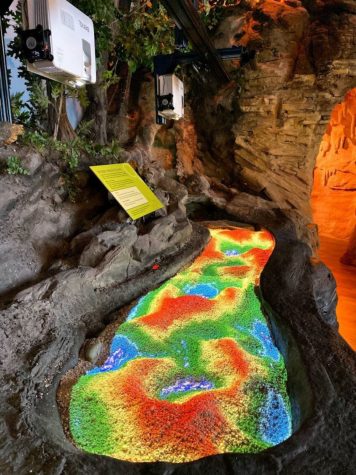UI 3D club, Science Center of Iowa create AR Sandbox
The University of Iowa 3D club partnered with the Science Center of Iowa to create a custom augmented reality sandbox for educational purposes.
Tyler Bell, assistant professor of electrical and computer engineering, poses for a portrait on Friday, Oct. 25, 2019. Bell worked with the UI 3D Club to launch their AR sandbox at Science Center of Iowa in Des Moines. (Hannah Kinson/The Daily Iowan)
October 31, 2019
Playing in the sand is being taken to the next level as the University of Iowa 3D Club partnered with the Science Center of Iowa to make an interactive sandbox for kids to learn about topography.
The idea began when the 3D club reached out to Tyler Bell, an assistant professor in electrical and computer engineering, who had the idea of creating an AR sandbox, said Cody Wilson, the 3D club president.
“The AR sandbox is a system that allows users to interact and play in the sand and have the topography re-projected back onto the sand,” Bell said. “Where the elevation of the sand is higher, the color is red. Where the elevation is lower, the color is blue.”
An augmented reality sandbox is not a new concept. It was first made popular by researchers at UC Davis, explained Bell. Seeing this, Bell reached out to the Des Moines Science Center of Iowa and expressed that the club had a bunch of students who were interested in the project.
“It was kind of perfect timing, because the Des Moines Science Center was in the market for purchasing an AR sandbox,” Wilson said.
The UI 3D club began discussions with the science center last spring, Bell said. The group designed the structure over the summer, and at the start of the semester they ordered the parts and began putting the sandbox together.
RELATED: UI students design 3D printed prosthetics for kids in need
“What we did was make it a little unique for the science center,” Bell said. “They wanted one that would be much larger than the typical AR sandbox. So that’s what we ended up making for them is a large-scale augmented sandbox.”

First, the club built the frame that was going to hold the projectors, said Derrick Johnson, 3D club treasurer. From there, they calibrated the projectors to make sure the depth and topography of the map was able to work in live time. The team then took the frame, projectors, and the coding and drove it to Des Moines to be installed in the Science Center exhibit.
“To be able to have a project and partnership with the science center of Iowa was a huge goal of ours,” Johnson said.
The team utilized the partnership to make their dream project come to real life.
“Now, we have an AR sandbox that is not only run by one computer program but also incorporates two projectors and two 3D scanners in order for 10 or 12 kids to play with the AR sandbox at one time,” Bell said.
This project is one of the first projects that the UI 3D club has set in place. The club’s first project was to build Erica Cole, a student entrepreneur at the UI, a prosthetic so that she could scuba dive, Wilson said. Originally her prosthetic cost about $22,000 but the club was able to manufacture her a prosthetic for scuba diving for $75, Wilson said.
Wilson explained that the UI 3D club’s initial goal was to figure out how to use this cutting-edge technology to better other people’s lives.
RELATED: UI student creates prosthetic limb covers
“It all started last year, 2018 fall semester. I got together with a few of my friends, and we decided that 3D printing is a huge technology that is being used in the industry,” Wilson said.
The team decided there was a need to expand their 3D-printing technology beyond its current uses. The expansion of the club involved introducing a whole other portion of 3D that is not 3D printing – 3D imaging, virtual reality, and augmented reality, Bell said.
“The 3D club is a collection of students in all sorts of departments that are coming together and building things for specific problems,” Bell said.
The AR sandbox is currently being used at the Des Moines Science Center for the use of topography education, said Wilson. Specifically, teaching kids about how you can study the ways weather reacts with the different mountains and valleys and ridges as landscapes change, said Wilson.
“In the future this AR technology can be used in the surgical sector. You can use this 3D scanned data to 3D scan your patient and project on top of the patient where incisions could be or step by step instructions, giving the surgeon more precision,” said Wilson.






